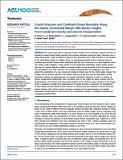Por favor, use este identificador para citar o enlazar a este item:
http://hdl.handle.net/10261/167238COMPARTIR / EXPORTAR:
 SHARE SHARE
 CORE
BASE CORE
BASE
|
|
| Visualizar otros formatos: MARC | Dublin Core | RDF | ORE | MODS | METS | DIDL | DATACITE | |

| Título: | Crustal Structure and Continent‐Ocean Boundary Along the Galicia Continental Margin (NW Iberia): Insights From Combined Gravity and Seismic Interpretation |
Autor: | Druet Vélez, María CSIC ORCID; Muñoz-Martín, Alfonso CSIC ORCID ; Granja Bruña, J. L.; Carbó Gorosábel, Andrés; Acosta-Yepes, Juan; Llanes Estrada, Pilar; Ercilla, Gemma CSIC ORCID | Fecha de publicación: | may-2018 | Editor: | American Geophysical Union | Citación: | Tectonics 37(5): 1576-1604 (2018) | Resumen: | The magma‐poor rifted continental margin of Galicia has an extremely complex structure. Its formation involved several rifting episodes that occurred ultimately during the early Cretaceous near a ridge triple junction, which produced a change in the orientation of the main structures in its transition to the north Iberia margin. In addition, there is a superimposed partial tectonic inversion along its northwest and northern border which developed from the Late Cretaceous to at least Oligocene times. The present study integrates a large volume of new geophysical information (mainly marine gravity data and 2‐D seismic reflection profiles) to provide insights on the formation of this rift system and on the development of its later inversion. The combined interpretation and modeling of this data enable the presentation of a new crustal and structural domain map for the whole Galicia margin. This includes the rift domains related to the extreme thinning of the crust and the lithospheric mantle (stretched, necking, and hyperextension and mantle exhumation domains), as well as a domain of intense compressional deformation. New constraints arise on the origin, the deep structure, and the characterization of the along‐ and across‐strike variation of the continent‐ocean transition of the margin, where a progressive change from hyperextension to partial inversion is observed. The development of both rifting and later partial tectonic inversion is influenced by the existence of former first‐order tectonic features. Most of the tectonic inversion is focused on the hyperextension and mantle exhumation domain, which in some areas of the northwestern margin is completely overprinted by compressional deformation | Descripción: | 29 pages, 3 figures, 1 table, supporting information https://doi.org/10.1029/2017TC004903 | Versión del editor: | https://doi.org/10.1029/2017TC004903 | URI: | http://hdl.handle.net/10261/167238 | DOI: | 10.1029/2017TC004903 | Identificadores: | doi: 10.1029/2017TC004903 issn: 0278-7407 e-issn: 1944-9194 |
| Aparece en las colecciones: | (ICM) Artículos (IGME) Artículos |
Ficheros en este ítem:
| Fichero | Descripción | Tamaño | Formato | |
|---|---|---|---|---|
| Druet_et_al_2018.pdf | 2,25 MB | Adobe PDF |  Visualizar/Abrir | |
| Druet_et_al_2018_suppl_1.docx | 7,74 MB | Microsoft Word XML | Visualizar/Abrir |
CORE Recommender
SCOPUSTM
Citations
21
checked on 18-abr-2024
WEB OF SCIENCETM
Citations
16
checked on 27-feb-2024
Page view(s)
334
checked on 19-abr-2024
Download(s)
1.172
checked on 19-abr-2024
Google ScholarTM
Check
Altmetric
Altmetric
NOTA: Los ítems de Digital.CSIC están protegidos por copyright, con todos los derechos reservados, a menos que se indique lo contrario.
